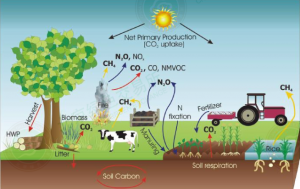10 Major Industries Ranked By Climate Action Progress
The Climate Crisis team on Quora asked me to assess which industries are ahead and behind in terms of dealing with climate solutions. I’d just finished reading Kahneman’s Noise: A Flaw in Human Judgment (strongly recommended), so instead of attempting to provide a multifactorial scoring, I decided to go with a ranking mechanism instead.
And so, my list with color commentary of the major industries which are addressing or challenged to deliver or hostile to climate action, from best to worst.
1. Wind Industry
Wind energy is the biggest new source of low-carbon energy on the planet at present. About 140 GW of capacity with an average capacity factor around 40% was commissioned in 2020, 50% of that in China. As electricity is the future of all energy, being the biggest single provider of new low-carbon electricity pretty much puts you on the top of the heap.
Every MWh of wind energy displaces a MWh of fossil fuel energy with its median 750 kg of CO2 emissions, so last year’s 140 GW of capacity turns into annual CO2 emissions reductions of about 350 million tons of avoided CO2 every year for the next 30 years. Wind energy is the current work horse of CO2 avoidance, hence the reason I’ve spent so much time in the space.
Big providers in order are:
- Vestas – Europe
- Siemens Gamesa – Europe
- Goldwind – China
- GE – USA
- Envision – China
Hmmm… Europe and China are kicking butt and taking names here.
Ørsted gets an honorable mention in this too. It used to be an oil and gas major. Then it saw the light. Now it’s dumped the carbon blight entirely, and is the biggest offshore wind deployer in the world. Also European. Go Europe!
2. Solar Industry
Solar is the second biggest source of new low-carbon electricity in the world, about 100 GW in 2020, once again 50% in China. So that’s pretty damned skippy, and represents about 150 million tons of avoided CO2 annually for the next 30 years.
And what are the companies there?
- LONGi Solar – China
- Jinko Solar – China
- JA Solar – China
- Trina Solar – China
- Canadian Solar – China
Yeah, China owns this market. You have to get down to #8 before you find a non-Chinese manufacturer, First Solar from the US.
Which is why there’s this big Sinophobic lobbying push happening in the US and Europe to cast Chinese solar panels as made with coal and slave labor. I wish I was making this up, but WSJ editorials, observation of social media, and a bit of insider knowledge on my part makes it clear to me that this is occurring.
Resist the Sinophobic BS. We have about 3 billion solar panels on the planet right now, and we need a lot more. China is the only scaled manufacturer of solar panels and many other climate action necessities, and is doing a lot better on climate action than western media portrays, especially the right-wing media, so buy Chinese already.
3. Electronics
Wait. What? Electronics? Yeah, electronics.
LEDs have caused lighting and video energy consumption to virtually disappear from the radar screen. 75% energy reduction out of the box. Integrated circuits have made virtually every home appliance an energy sipper, not an energy hog. TVs and monitors? Vastly more of them, vastly less energy used.
Our smartphones replace dozens of comparatively high-energy requirement devices from tape recorders to video recorders to landline telephones to printed books to flashlights to newspapers and on and on.
People kvetch about data center energy usage, but it’s absurd how far a kWh of electricity goes in 2021 vs in 1980. Not only is the future of all energy electricity, we’ve become incredibly parsimonious about most of its uses.
Sure there’s pollution and waste. But when it comes to climate change, energy is Satan incarnate, and electronics have vastly reduced how often Satan is hanging around our homes smelling of brimstone and long-chain polymers. The biggest story in overall efficiency is electronics.
4. HVAC — Okay, Heat Pumps
Heating, ventilation, and air conditioning is going through a double revolution. It’s a big honking energy consumer. But it’s shifting more and more to electricity because baseboard heaters and AC are cheap and convenient, and electricity is decarbonizing.
You can’t decarbonize natural gas or oil heat.
But the second revolution is heat pumps. There’s something called the coefficient of performance (COP). It basically says how much heating or cooling you get per unit of energy input. With natural gas or oil, the absolute maximum is a COP of 1. That means 100% of the energy heats the place.
But heat pumps get COPs of 3–5. Wait. That’s 300% to 500% of energy in output as heat or cold! How do we go over unity! Call the Thermodynamics police!
Well, it’s simple. Heat pumps don’t create heat or cold, they pump heat from one place to another. They are air conditioners, but instead of just pumping heat out, they also pump heat in. And they do it with electricity, so as grids decarbonize with wind and solar, heating and cooling of buildings with heat pumps decarbonizes further in lockstep.
And heat pumps and HVAC in general are subject in most major economies to the Kigali Amendment to the Montreal Protocol. The who-what? The Montreal Protocol is the ozone layer saver. It replaced really nasty CFCs with HFCs in refrigerators, air conditioners, and aerosol cans globally, patching up the ozone layer as a result. And HFCs are a bit less warming than CFCs, so that was accidentally good. But a bit less warming still means 1300–14,000 times worse than CO2. Whoops.
The Kigali Amendment, which followed the Paris COP21 meeting a few months later, but in Rwanda, started to fix that. Basically, it said signatories had to start replacing high global warming potential (GWP) HFCs with lower GWP HFCs, HFOs, and CO2. Yeah, carbon dioxide. It’s a coolant when used as a refrigerant, which of course climate change deniers make into a stupidity test.
So modern heat pumps get 3–5 times the energy efficiency, their refrigerants don’t create global warming nearly as much, and they get more virtuous as the grids they are on decarbonize. Win, win, win!
5. Ground Transportation
Yeah, Tesla. And others. And 38,000 km of high speed electrified rail in China. And 430,000+ electric buses in China. And 19,000 km of high-speed rail in Europe. And 50% of all EVs being bought in China. Lots of electrified freight transport in Europe.
And lots of transit, e-bikes, e-scooters, e-unicycles, and the like everywhere in the world.
Lots of good stuff happening in ground transportation from a climate perspective, but still a long way to go.
6. Forestry
Here’s the deal. Planting a trillion trees will bridge a couple of decades of human emissions. And leaving them alone will enhance long term soil carbon sequestration. Further, cutting down the mature trees and turning them into durable wood products like furniture and load-bearing beams for construction sequesters that carbon for a long time.
So the forestry industry has a big part to play. But it’s not there yet.
Canada and Scandinavia are leading in engineered wood beam construction, with approvals for 12- and 16-story buildings respectively. Think plywood load-bearing beams instead of reinforced concrete.
Canada certainly has a lot of newly planted forests. And a bunch of clear cut ones too. I’ve sat in a clear cut on the way to Tofino, shaken to my core. It’s ugly. And I’ve personally pushed 12,000 seedlings into the ground while being towed on a planting trailer behind a tractor in a single weekend. Much more uplifting.
But they are working on it. Seedling planting by drones is a thing now, although survival rates are currently low. Having met a lot of tree planters, I’m pretty sure that the machines will outperform them eventually, if they aren’t already.
China has planted an area larger than the size of France with more than 40 billion trees since 1990.
Has that sunk in yet?
I’ll repeat it nonetheless. China has planted an area larger than the size of France with more than 40 billion trees since 1990.
That’s the forestry industry in action. Unfortunately, the rest of the world isn’t doing nearly as well as China, and to be clear, China deforested all of that first.
7. Agriculture
There’s a lot of ugly and a lot of good in agribusiness.
The land actually under cultivation has barely changed since 1950. We’re feeding vastly more people with the same land area. And the amount of ammonia-nitrogen fertilizer has barely changed since 1950 either.
The population has tripled, but we are feeding them with close to the same land area and close to the same amount of fertilizer. Holy FSM (which I guess would be cannoli)!
Yeah, agribusiness has been totally rocking. Same inputs, massively more outputs.
But still. Agriculture is a big producer of greenhouse gases. And 40% of the total land mass of the world is used for agriculture. That land used to be a carbon sink, but now it’s a carbon emitter.
And ammonia-nitrogen fertilizer sucks from a GHG perspective. The ammonia is made from fossil-fuel derived hydrogen. The fertilizer turns into nitrous oxides with high GWPs. Something like 8x the mass of CO2 is release per pound of fertilizers. Agriculture is in the range of 8–10% of total global GHG emissions annually.
That circle is not yet squared.
However, things are changing, and pretty quickly. Agribusiness is not a conservative, slow moving industry. You don’t triple outputs and maintain inputs since 1950 without being quick to adopt innovations. And now there are three innovations pushing through the global agribusiness world.
The first is precision agriculture. GPS guided, computer-controlled dispensation of seeds, pesticides, water, and fertilizer in precise amounts as needed. Electronics again.
The second is low-tillage agriculture. Leaving the sub-surface soil alone keeps the CO2 in the root system in place longer. And leaving it in place and not disrupting the fungal soil network gives time for the glomalin protein pathwayfor long term soil carbon capture to work.
The third is biogenetics. Multiple firms are working on making agriculture crops and their biomes more efficient and effective. I spent 90 minutes recently with Karsten Temme, the PhD CEO of PivotBio, which genetically engineers nitrogen-fixing microbes and then brews them in beer vats to spread on fields. 20–25% fertilizer use reduction for 6–7% crop yield improvements. That’s pretty big. And its goal is 100% fertilizer reduction by 2030. (Podcast coming shortly).
8. Air Transportation
Because so much of air travel is international, dealing with emissions is assigned not to flow down targets to countries, but to the International Civil Aviation Organization (ICAO). It’s supposed to be acting to bring global carriers to reduced and zero emissions, but it’s incredibly slow and toothless.
To be clear, low-carbon bio- and synthetic jet fuels have been certified for use in aviation since at least 2011, but outside of a few demonstration efforts, aren’t used.
In part, this is because aviation is a hard target, not a soft one. Planes fly by throwing massive amounts of energy to get and keep high speed air flowing under a lifting surface. Doing that for up to 15 hours (my personal longest flight) is staggering.
But there is hope there. I’ll be speaking with the CEO of Heart Aerospace sometime this month or early next. The company has orders for a 19-seat regional electric plane and reasonable funding on its current round. All of the major aerospace manufacturers are looking at electric and electric hybrid. There’s even ZeroAvia, a hydrogen drivetrain startup that Gates’ Breakthrough Ventures is invested in.
We are a long way from having solved this knotty problem, but there is at least work being done.
9. Water Freight Shipping
We’re already seeing some short haul freight shipping electrifying, and ferries and the like are electrifying rapidly. It’s the medium and long haul shipping which remain untouched.
And they typically run on bunker oil, which is to say one of a hundred different variants of barely refined petroleum products that are below diesel and barely above crude oil. It’s nasty stuff and heavily polluting in addition to its CO2 emissions. As Mark Z. Jacobson points out, they emit a lot of unburned hydrocarbons and soot, black carbon, which has a very high global warming potential.
I spent an hour recently talking with a PhD mechanical engineer who has spent the last four years of his career designing, constructing, installing and certifying the scrubbers that go on these vessels to reduce particulate and chemical emissions down to barely tolerable levels that among other things, pass the visual test with seemingly harmless white smoke coming out of the stacks. Non-trivial and does nothing for the CO2.
Long haul oceanic shipping is one of the only modes of transportation where I consider hydrogen drivetrains to have an actual play.
But oceanic shipping is the worst of the worst of the problems. It’s all under flags of convenience, it’s usually in international waters and it’s a low-margin, competitive business.
10. Industrial Processes
Industrial processes like cement, steel, and the Solvay process are way behind. They are poking around the edges so far, and there are enormous amounts of industrial commodities being produced in high-carbon approaches. There are bright spots of innovation that have no penetration, like renewably-powered green hydrogen reduction of iron ore into steel foam, and electrochemistry processes that displace the Solvay process for carbonates (look for the CleanTechnica three-part series publishing Aug 14/15 featuring Agora Energy Technologies which covers this). But these are early days. Lots of work to do there.
Oil and gas. Coal. The fossil fuel industry is greenwashing hard and despite its claims, is massively failing to address the most pressing concern of the 21st Century.
Ørsted was mentioned earlier. They got it: oil and gas are destructive coming and going. And they got out. Now they are productive members of society.
The rest of the companies that are still standing after the bloodbath of bankruptcies and mergers of the past decade? Nothingburgers.
Carving off molecule-thin shavings of their emissions to do enhanced oil recovery, push ‘blue’ hydrogen, and promoting it into some vague semblance of green, while lobbying hard with politicians they fund to make it seem like a solution, instead of a continuation of the problem.
Sources:
https://cleantechnica.com/2021/08/13/10-major-industries-ranked-by-climate-action-progress/







My family all the time say that I am wasting my time here at web, except I know I am
getting know-how daily by reading such good articles or reviews.
Hey, I think your blog might be having browser compatibility issues. When I look at your blog site in Chrome, it looks fine but when opening in Internet Explorer, it has some overlapping. I just wanted to give you a quick heads up! Other then that, excellent blog!
Howdy! Quick question that’s entirely off topic. Do you know how to make your site mobile friendly? My site looks weird when viewing from my apple iphone. I’m trying to find a theme or plugin that might be able to correct this problem. If you have any recommendations, please share. Many thanks!
Ahaa, its nice conversation about this piece of writing here
at this website, I have read all that, so at this time me also commenting here.